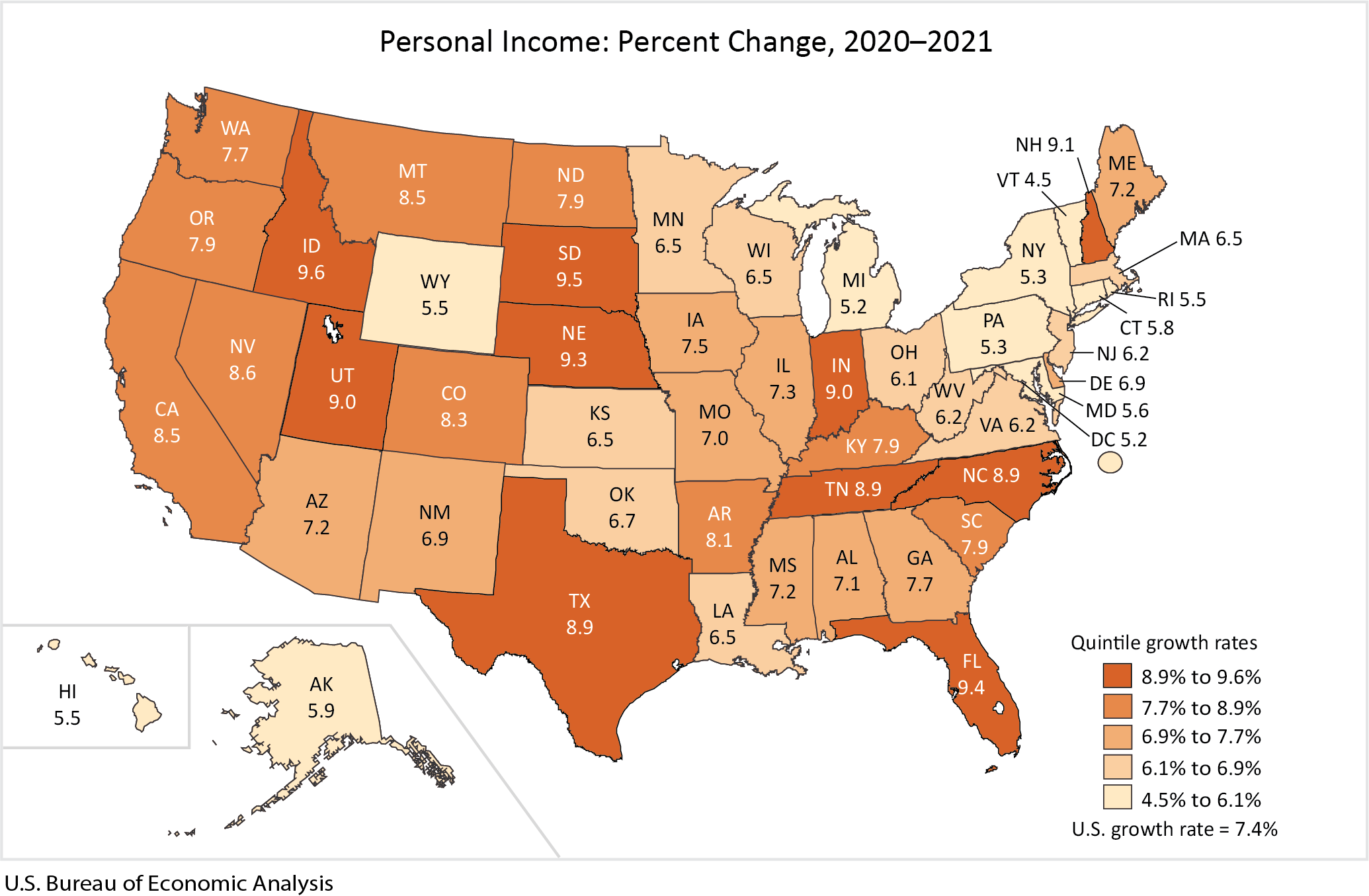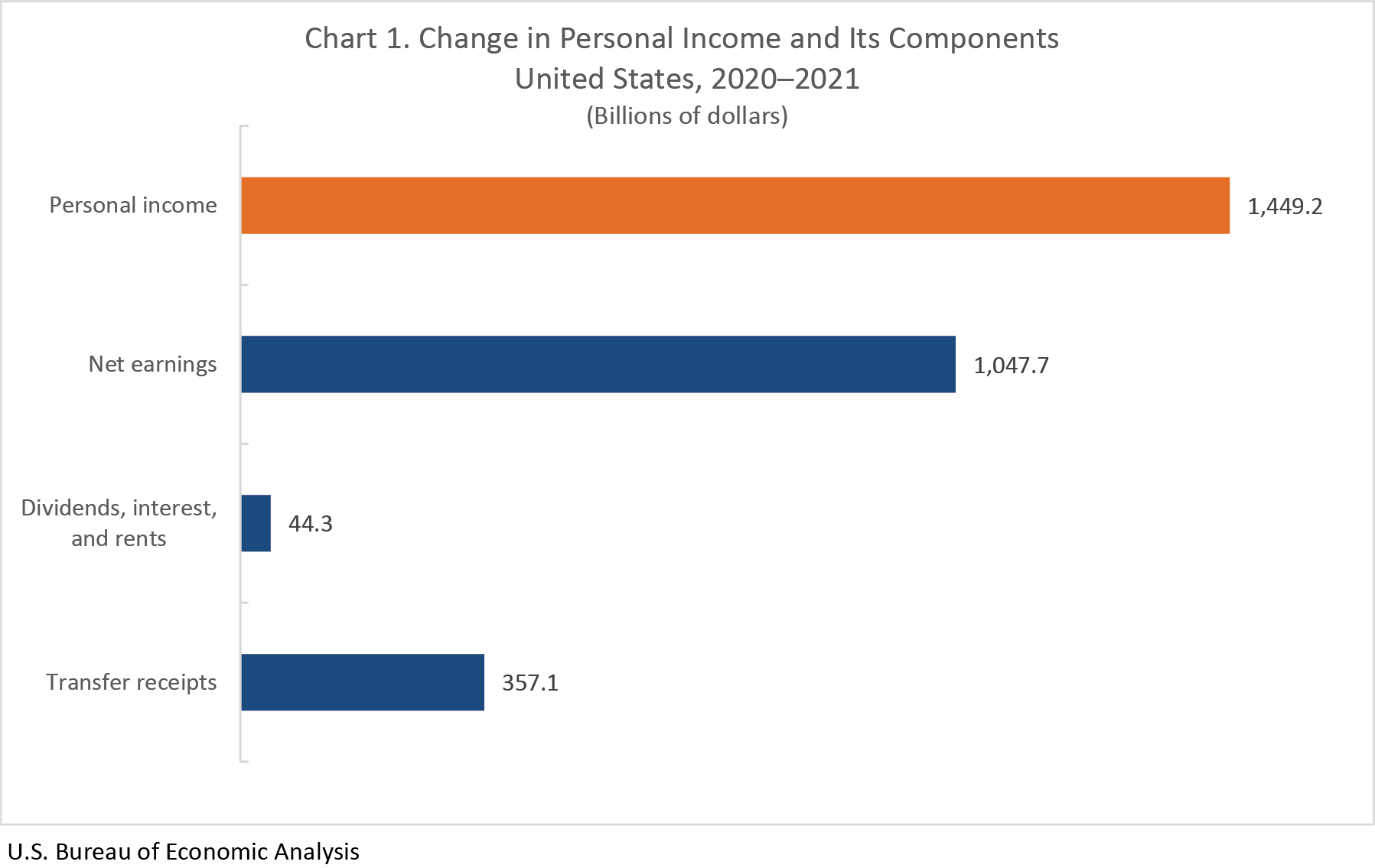News Release
Personal Income by State, 2021 (Preliminary) and 4th Quarter 2021
State personal income increased 7.4 percent in 2021 after increasing 6.6 percent in 2020, according to estimates released today by the Bureau of Economic Analysis (BEA) (table 1). In 2021, increases in earnings, transfer receipts, and property income (dividends, interest, and rent) contributed to personal income growth in all states and the District of Columbia (table 2). The percent change in personal income across all states ranged from 9.6 percent in Idaho to 4.5 percent in Vermont.
Earnings. Earnings increased 8.9 percent, accounting for most of the $1.4 trillion dollar increase in personal income for the nation in 2021 (chart 1). The increase in earnings reflected the continuing reopening of the economy following the onset of the COVID-19 pandemic in the first quarter of 2020.
Earnings increased in all 24 industries for which BEA prepares estimates (table 4). The largest increases were in professional, scientific, and technical services; health care and social assistance; and retail trade. The percent change in earnings across all states ranged from 12.2 percent in New Hampshire to 3.5 percent in Alaska (table 2).
- In Idaho, the state with the largest increase in personal income, increases in earnings in construction and retail trade were the largest contributors to growth in personal income.
- In South Dakota, the state with second largest increase in personal income, an increase in farm earnings was the largest contributor to growth in personal income.
Transfer receipts. Transfer receipts increased 8.4 percent for the nation in 2021 after increasing 35.1 percent in 2020. Transfer receipts increased in all states and the District of Columbia, ranging from 18.1 percent in Alaska to 1.2 percent in Vermont (table 2). The increases in transfer receipts reflected continued payments from pandemic response legislation including the Coronavirus Response and Relief Supplemental Appropriations Act and the American Rescue Plan Act.
Property income. Property income increased 1.2 percent for the nation in 2021 after decreasing 1.0 percent in 2020. Property income increased in all states and the District of Columbia, ranging from 2.6 percent in Utah to 0.3 percent in Louisiana.
The 2021 annual and 2021 fourth-quarter estimates of state personal income reflect the continued economic impacts related to the COVID-19 pandemic. The 2021 annual estimates reflect the continued economic recovery, reopening of establishments, and continued government response related to the COVID-19 pandemic.
The fourth quarter estimates reflect an increase in COVID-19 cases resulting in continued restrictions and disruptions in the operations of establishments in some parts of the country. Government assistance payments in the form of forgivable loans to businesses and social benefits to households all decreased as provisions of several federal programs expired or tapered off. The full economic effects of the COVID-19 pandemic cannot be quantified in the state personal income estimates because the impacts are generally embedded in source data and cannot be separately identified. For more information, see "Federal Recovery Programs and BEA Statistics."
State Personal Income, Fourth Quarter 2021
State personal income increased 2.4 percent at an annual rate in the fourth quarter of 2021 after increasing 3.0 percent in the third quarter (table 5). Increases in earnings and property income were partially offset by decreases in transfer receipts. The decrease in transfer receipts reflected lower state unemployment insurance compensation payments. The percent change in personal income across all states ranged from 9.2 percent in Texas to –8.7 percent in North Dakota (table 6).
Increases in earnings in mining were the leading contributor to increases in personal income in Texas and Oklahoma, the states with the largest and third largest increase in personal income (table 8).
Farm earnings was the leading contributor to decreases in personal income in North Dakota and four other states including South Dakota, Iowa, Nebraska, and Kansas. The decrease in farm earnings followed decreases in payments to farmers from the Coronavirus Food Assistance Program and the Paycheck Protection Program.
Today, BEA also released revised quarterly estimates of personal income for the first quarter of 2021 through the third quarter of 2021. Updates were made to incorporate source data that are more complete and more detailed than previously available and to align the states with revised national estimates that were released on February 25, 2022.
BEA also released revised quarterly and annual estimates of population and per capita personal income for the second quarter of 2010 through the third quarter of 2021. BEA used new Census population figures to calculate per capita personal income estimates for the second quarter of 2020 through the fourth quarter of 2021. BEA also used new Census population figures to update annual 2020 per capita personal income statistics and to produce new per capita personal income statistics for 2021. For earlier estimates, BEA used intercensal population statistics that it developed based on Census' methodology. With these data, BEA updated its annual per capita personal income estimates from 2010 through 2019 and quarterly estimates for the second quarter of 2010 through the first quarter of 2020. BEA developed intercensal population statistics because these data were not available when Census released state population data for 2020 and 2021, based on the 2020 decennial counts.
BEA produced intercensal population figures to create consistent time series that are used to prepare per capita personal income statistics. BEA used the Census Bureau's application of the Das Gupta method, modified to account for an extra leap year day, to produce the intercensal population figures that will be used until Census releases its official intercensal population data.
Next release: June 22, 2022, at 8:30 a.m. EDT
Personal Income by State, 1st Quarter 2022


